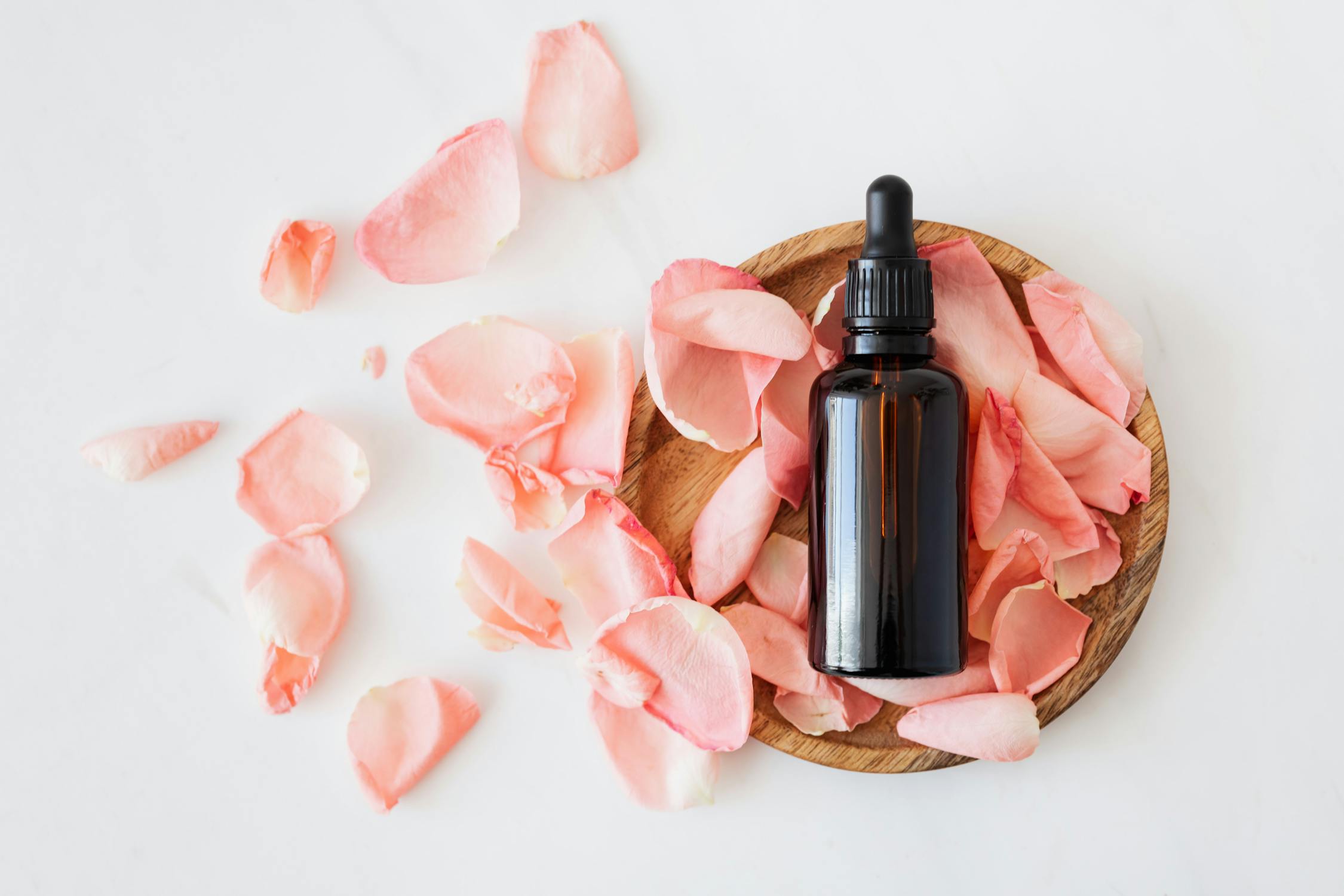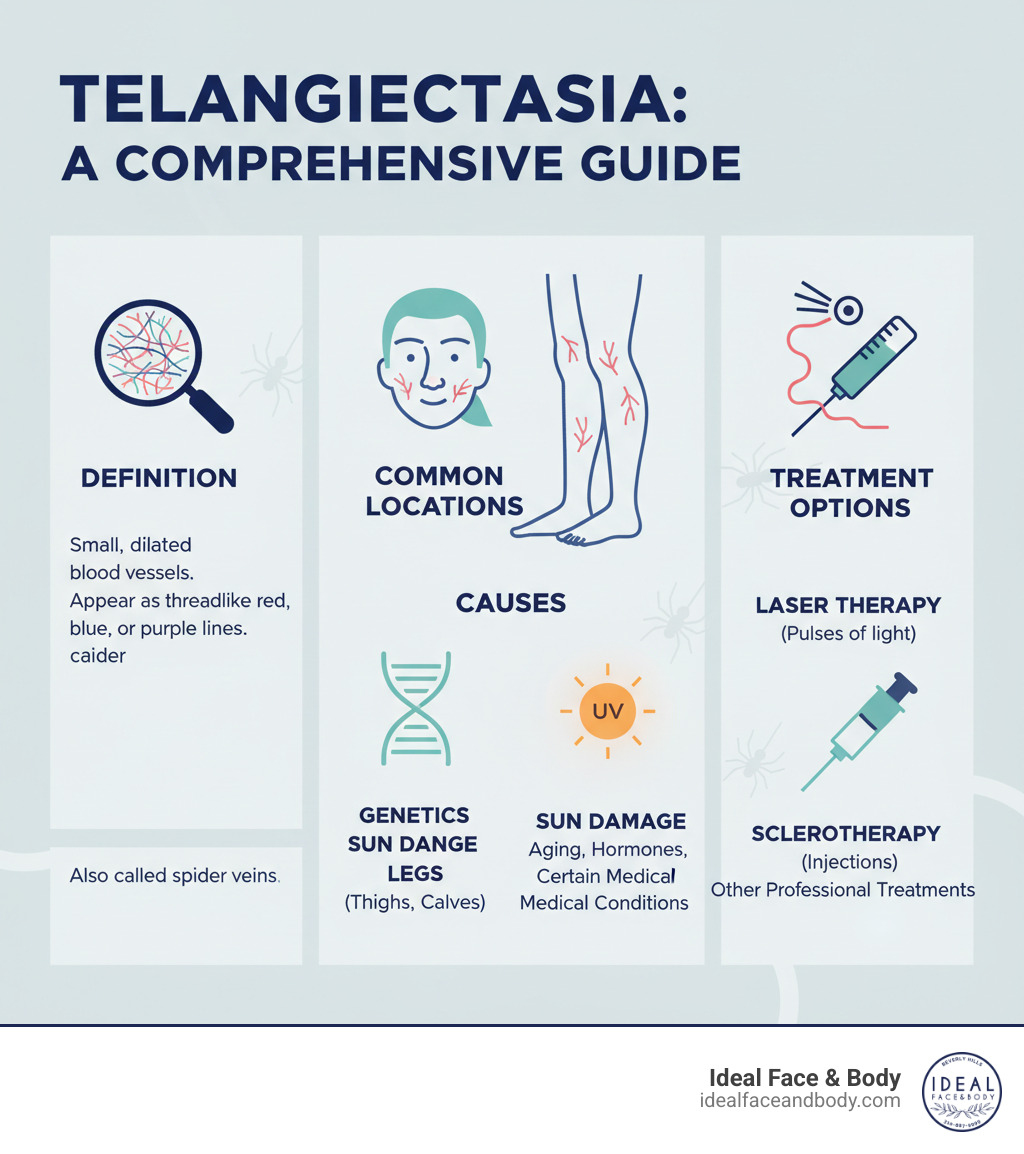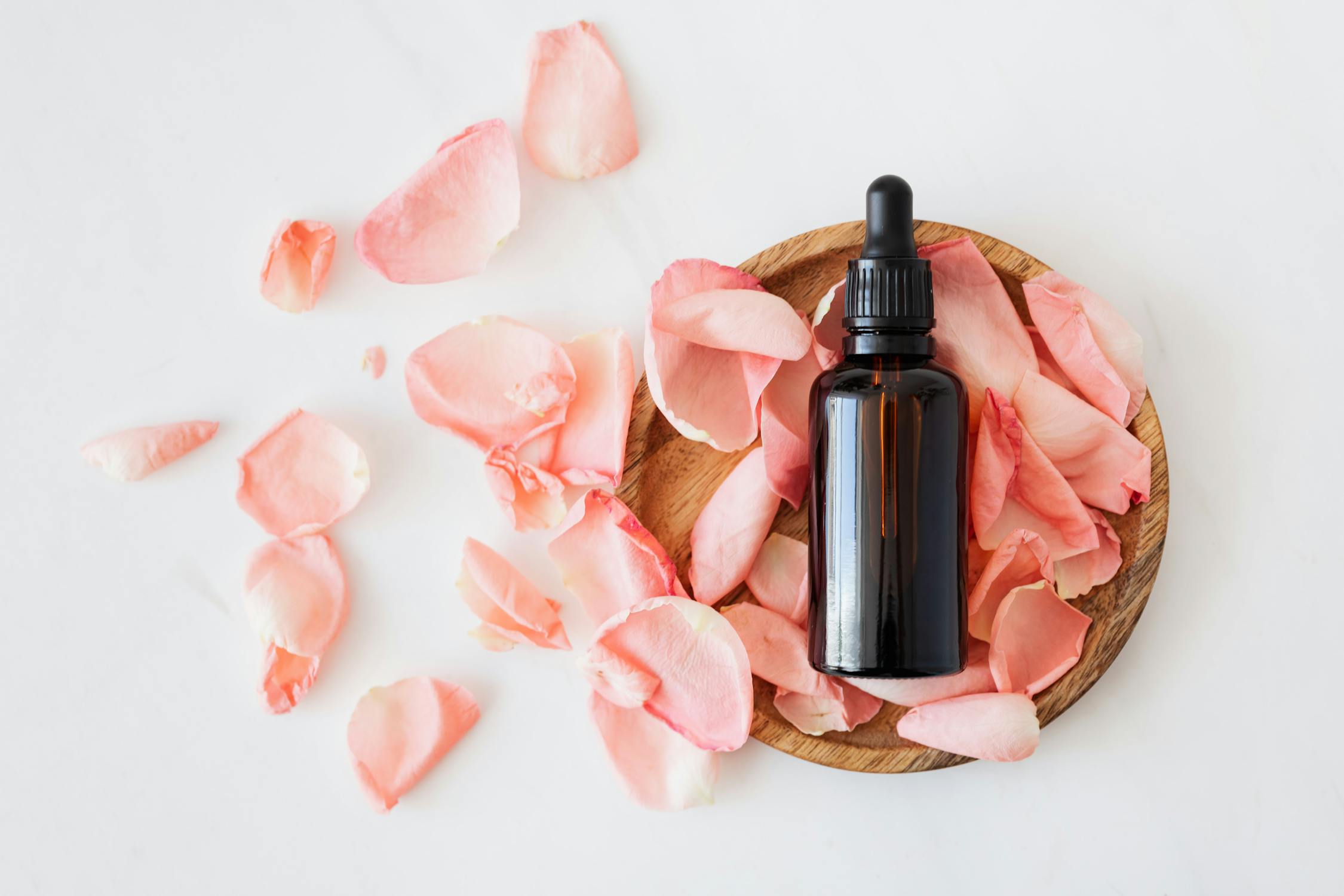What is Telangiectasia and Why Does it Matter?
Telangiectasia, also known as spider veins or broken capillaries, are small, dilated blood vessels that appear as threadlike red, blue, or purple lines on the skin. They form when tiny blood vessels near the surface become permanently widened.
Quick Definition:
- What it looks like: Fine red, blue, or purple lines that resemble spider webs
- Where it appears: Most common on the face (nose, cheeks, chin), legs, and hands
- What causes it: Genetics, sun damage, aging, hormones, and certain medical conditions
- Is it dangerous: Usually harmless but can indicate underlying health issues in some cases
- Can it be treated: Yes, with laser therapy, sclerotherapy, and other professional treatments
Telangiectasias affect up to 88% of women and 79% of men at some point in their lives, typically appearing between ages 30 and 50. While these small blood vessels are generally harmless, they can cause cosmetic concerns and sometimes signal more serious underlying conditions.
The visible red or blue lines form when the walls of tiny blood vessels called capillaries, arterioles, or venules lose their ability to contract properly. This causes them to remain dilated and become visible through the skin. On the face, they often appear around the nose and cheeks, while on the legs they typically show up as clusters of fine lines.
Dr. Sarah Yovino brings years of specialized experience in treating telangiectasia through advanced laser therapies and minimally invasive procedures at Ideal Face & Body in Beverly Hills. Her expertise in pain management allows her to provide comfortable, effective treatments for spider veins and other vascular concerns using state-of-the-art technology.
Understanding the Causes and Risk Factors
The reasons behind the appearance of telangiectasia are a mix of inherited factors and life experiences. Understanding these causes is the first step toward effective management. At Ideal Face & Body in Beverly Hills, our approach begins with understanding your individual risk factors.
Genetics plays a major role; research shows that 90% of people with spider veins have a family history of them.
Hormonal changes are another key factor, especially for women. Pregnancy is a common trigger, with women being four times more likely than men to develop them due to surging hormones and increased pressure on veins. Birth control pills and hormone replacement therapy can also contribute.
Aging is an unavoidable factor. As we age, skin thins and blood vessels lose elasticity, making them more fragile. Most people first notice spider veins between ages 30 and 50.
Chronic sun exposure is a leading cause of facial telangiectasia, as UV rays damage the collagen that supports blood vessel walls. This is why they often appear on the nose and cheeks.
Rosacea, a common inflammatory skin condition, frequently presents with facial redness and prominent blood vessels.
Lifestyle choices also matter. Excessive alcohol consumption, jobs that require prolonged standing or sitting, and excess weight can all contribute to the formation of telangiectasia.
Common Causes of Acquired Telangiectasia
Many telangiectasia cases develop from life events.
- Environmental damage: Chronic sun exposure and extreme temperatures can weaken delicate blood vessels.
- Physical trauma: Minor skin injuries like cuts or bruises can sometimes result in localized telangiectasia.
- Overuse of topical steroids: Prolonged use of steroid creams can thin the skin and weaken blood vessel walls.
- Venous problems: For leg telangiectasia, weak valves in larger veins can cause blood to pool, increasing pressure in smaller capillaries. Studies show that 88-89% of women with leg telangiectasia have underlying venous issues. At Ideal Face & Body, we evaluate for these root causes to ensure comprehensive treatment.
Genetic and Inherited Conditions
While most cases are cosmetic, some telangiectasia can signal serious genetic conditions.
- Hereditary Hemorrhagic Telangiectasia (HHT): A rare disorder causing abnormal blood vessel formation throughout the body, including internal organs, which can lead to serious bleeding.
- Ataxia-telangiectasia: A rare inherited disorder affecting the nervous and immune systems, causing coordination problems and telangiectasia in the eyes and on the skin.
- Bloom syndrome: A rare genetic disorder characterized by short stature, sun sensitivity, and facial telangiectasia.
- Benign hereditary telangiectasia: This condition causes widespread telangiectasia without the dangerous internal issues of HHT, making it primarily a cosmetic concern.
- Rosacea: This condition also has genetic components that increase the likelihood of developing associated telangiectasia.
For more detailed medical information about these conditions, you can explore an overview of spider veins from StatPearls.
When Spider Veins Signal a Deeper Health Issue
Most of the time, telangiectasia are a cosmetic concern. However, they can sometimes signal a more significant underlying health issue. At Ideal Face & Body, Dr. Sarah Yovino and Dr. Justin Yovino conduct thorough assessments to rule out any underlying conditions.
Autoimmune diseases are a primary concern where telangiectasia serve as clues.
- In scleroderma (specifically CREST syndrome), telangiectasia are a key feature, often appearing on the face, hands, and characteristically around the fingernails.
- Lupus can also cause telangiectasia around the nail folds, which may correlate with disease activity.
- In dermatomyositis, telangiectasia often appear in a V-shape on the chest or a “shawl” pattern over the shoulders.
Liver disease can manifest as spider angiomas, a specific type of telangiectasia with a central red spot and radiating lines, which can indicate poor liver function.
The most serious concern is Hereditary Hemorrhagic Telangiectasia (HHT), a genetic condition where telangiectasia form inside the body, potentially causing serious bleeding in the lungs, brain, or digestive tract.
When should you be concerned? While most cases are benign, certain red flags warrant medical attention. See a doctor if your telangiectasia:
- Appear suddenly or spread rapidly.
- Bleed, especially with frequent nosebleeds.
- Become painful or change in appearance.
- Are accompanied by other symptoms like shortness of breath, dizziness, or neurological changes.
The good news is that the vast majority of telangiectasia are harmless. Our Beverly Hills practice can help determine if yours are a cosmetic issue or require further medical evaluation.
How Telangiectasia is Diagnosed and Treated
At Ideal Face & Body in Beverly Hills, our diagnostic process is thorough yet straightforward, led by the expertise of Dr. Sarah Yovino and Dr. Justin Yovino.
The process begins with a physical examination of the affected skin. We may use diascopy (pressing a glass slide against the skin) to confirm the marks are blood vessels. A detailed medical history review helps us understand your unique situation, including family history, medications, and lifestyle.
For leg telangiectasia, a non-invasive duplex ultrasound may be recommended to check for underlying venous issues, ensuring we treat the root cause. In most cosmetic cases, these steps are all that’s needed. If a more serious condition is suspected, we may recommend further tests.
Once we have a complete picture, we can discuss the best treatment options for you. Learn more at our spider vein treatments page.
Professional Treatments for Telangiectasia
Modern medicine offers highly effective ways to eliminate telangiectasia. At Ideal Face & Body, we use the latest technologies for clear, beautiful skin.
Laser therapy is excellent for facial veins. It uses concentrated light to heat and collapse the vessel walls, which are then naturally reabsorbed by the body. Our laser options include:
- KTP laser: For smaller, superficial red veins.
- Intense Pulsed Light (IPL): Targets various vein sizes and improves overall skin tone.
- Pulsed Dye Laser: The gold standard for superficial red facial vessels.
- Nd:YAG laser: Penetrates deeper, ideal for larger blue telangiectasia on the legs.
- Laser Genesis: A gentler option that also boosts collagen production.
Sclerotherapy is the gold standard for treating telangiectasia on the legs. This minimally invasive procedure involves injecting a solution that causes the vein to close off and fade away. It’s a simple in-office procedure, and we often recommend compression stockings afterward to optimize results.
Electrodessication uses a fine needle and an electrical current to cauterize very fine vessels, typically on the face.
Microphlebectomy is a minimally invasive procedure to physically remove slightly larger, bulging spider veins through tiny incisions that don’t require stitches.
For more on the science behind these treatments, see this Cochrane review of treatments for telangiectasias.
Comparing Common Treatment Options
Choosing the right treatment depends on the location, size, and color of your veins, as well as your skin type. We’ll help you make an informed decision.
| Feature | Laser Therapy (e.g., KTP, PDL, Nd:YAG, IPL) | Sclerotherapy |
|---|---|---|
| Mechanism | Uses focused light energy to heat and collapse blood vessels. | Injects a chemical solution to irritate and close off blood vessels. |
| Best For | Facial telangiectasia (red, blue), very fine leg veins, diffuse redness. | Leg telangiectasia (red, blue), reticular veins, small varicose veins. |
| Invasiveness | Non-invasive (external application). | Minimally invasive (injection). |
| Pain Level | Generally well-tolerated; often described as a snapping or rubber band sensation. | Mild stinging or cramping during injection; typically brief. |
| Side Effects | Temporary redness, swelling, bruising, mild discomfort, hyper/hypopigmentation. | Temporary stinging, redness, bruising, swelling, brown lines, matting. |
| Downtime | Minimal to none; usually can resume normal activities immediately. | Minimal; strenuous exercise often advised against for a few days. |
| Sessions | Varies, often 1-3+ sessions for optimal results. | Varies, often 2-4+ sessions, typically spaced 4-6 weeks apart. |
| Key Advantage | No needles, excellent for facial veins, can treat diffuse redness. | Highly effective for leg veins, can treat multiple veins in one session. |
| Consideration | May not be as effective for larger, deeper leg veins. | Not typically used for facial veins due to potential side effects and proximity to eyes. |
Having both laser and sclerotherapy options at Ideal Face & Body allows us to create a truly customized treatment plan for you, sometimes combining techniques for the best outcome.
Frequently Asked Questions about Telangiectasia
At Ideal Face & Body in Beverly Hills, we believe in providing clear, honest answers to your questions about telangiectasia.
Can telangiectasias be prevented?
While you can’t completely prevent them if you’re genetically predisposed (which accounts for 90% of cases), you can significantly slow their development.
- Sun protection is crucial. Daily use of SPF 30+ sunscreen, especially in sunny Beverly Hills, is your best defense against facial veins.
- Be gentle with your skin. Avoid harsh scrubs and extreme temperatures.
- Manage underlying conditions. Controlling rosacea or venous insufficiency can prevent new spider veins from forming.
- Adopt a healthy lifestyle. Maintaining a healthy weight and limiting alcohol can reduce your risk. Avoid long-term use of topical steroid creams.
Do treatments for spider veins hurt?
Modern treatments for telangiectasia are designed for comfort. Most patients find them very tolerable.
- Laser therapy feels like a quick rubber band snap, and our systems have built-in cooling to improve comfort.
- Sclerotherapy involves a tiny needle pinch and possibly a brief, mild stinging sensation.
With Dr. Sarah Yovino’s expertise in pain management, we ensure your procedure is as comfortable as possible. Most patients say the anticipation was worse than the treatment itself.
Will telangiectasias come back after treatment?
A successfully treated vein is gone for good. However, the underlying factors that caused it (genetics, aging, sun exposure) still exist. This means new telangiectasia can develop over time in different spots. This isn’t a treatment failure but a continuation of a natural process.
Many patients opt for periodic touch-up treatments every few years to maintain their results. Dr. Justin Yovino and our team will provide detailed aftercare instructions, including wearing compression stockings and diligent sun protection, to help you enjoy your results for as long as possible.
Conclusion: Achieving Clearer, Healthier-Looking Skin
We’ve explored how telangiectasia, or spider veins, are a common concern influenced by genetics, lifestyle, and aging. While usually harmless, they can be a cosmetic issue and sometimes hint at underlying health conditions.
The great news is that you don’t have to live with them. Modern treatments like laser therapy and sclerotherapy are highly effective, safe, and more accessible than ever. A professional diagnosis is key to ensuring the right approach for your unique situation.
At Ideal Face & Body in Beverly Hills, our expert team, led by Dr. Sarah Yovino and Dr. Justin Yovino, combines cutting-edge technology with personalized care. We are dedicated to helping you achieve the clear, even-toned skin you desire.
If you’re ready to feel more confident in your skin, we’re here to help. Book a consultation for spider vein therapy at Ideal Face & Body today and let us help you unveil your most radiant self.









